Types and use of repair clamps
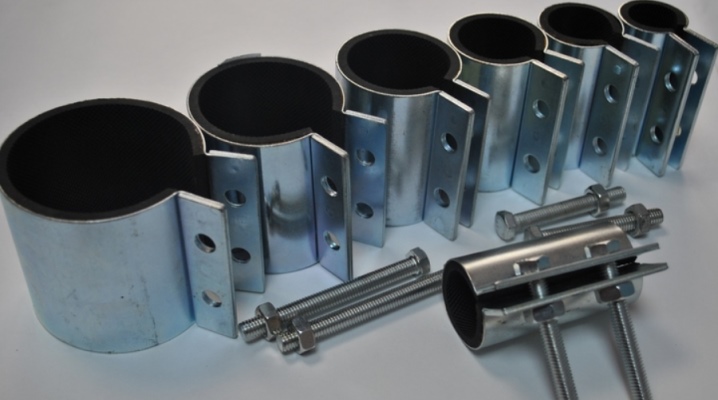
Repair (or emergency) clamps are intended for urgent pipeline adjustment. They are indispensable in situations where it is necessary to eliminate a water leak in a short time without completely or partially replacing pipes. Repair clamps are available in different standard sizes, and different materials are used for their manufacture.

Peculiarities
Repair clamps are classified as parts for sealing pipe systems. They consist of a frame, a crimping element and a seal - an elastic gasket that hides the resulting defects in the pipeline. Fixation is done with staples and nuts.
They are recommended for use on straight pipe sections installed in a horizontal or vertical plane. It is not allowed to mount products at joints or bends. Parts can be used for various types of pipes made from:
- cast iron;
- non-ferrous metals;
- galvanized and stainless steel;
- PVC, various types of plastic and other materials.
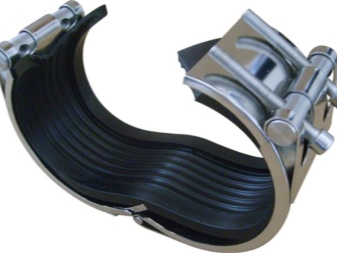
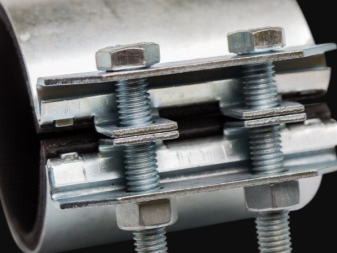
Repair clamps are installed at the sites of pipeline damage, they restore the functionality of the system and prevent subsequent deformation of the pipes.
Installation of emergency clamps is recommended:
- in the presence of fistulas in pipes resulting from corrosion;
- when rusting metal pipelines;
- when cracks occur;
- in case of breakouts arising from increased pressure in the system;
- in cases of urgent elimination of a leak when it is impossible to shut off the water;
- if necessary, sealing non-functional technological holes;
- with poor-quality welding work and leaking seams;
- in case of pipe breakage as a result of mechanical stress.
The advantages of such products include their versatility - the parts can be used not only to repair damage to pipelines, but also to fix horizontal or vertical pipes. They are easy to install - installation can be done without experience and specialized tools. Clamps are high temperature resistant, durable and affordable. Most types of such parts are made from 304 grade stainless steel, due to which they do not require additional corrosion treatment.
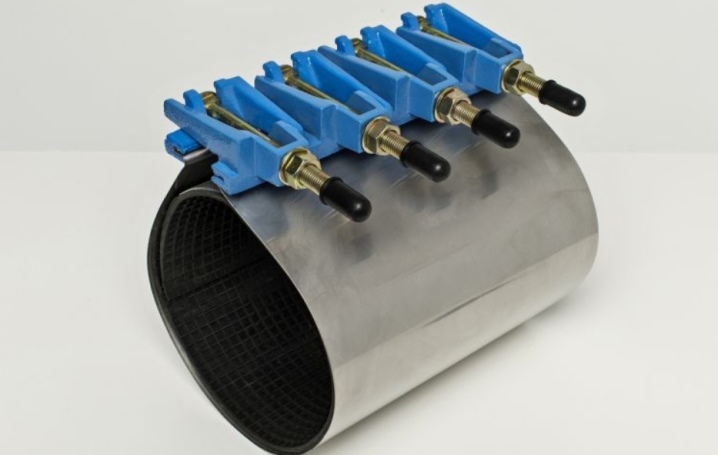
Clamps are universal - they can be used for pipelines of different sizes, if necessary, the same product can be installed several times. To carry out repair work, it will not be necessary to disconnect engineering networks. However, the use of clamps is a temporary measure. If possible, you should immediately replace the worn-out pipe with a whole one.
The disadvantages of emergency clamps include the ability to install them only on straight pipes. Another disadvantage is the limitation on use - the product is allowed to be mounted only when the length of the damaged area is no more than 340 mm.
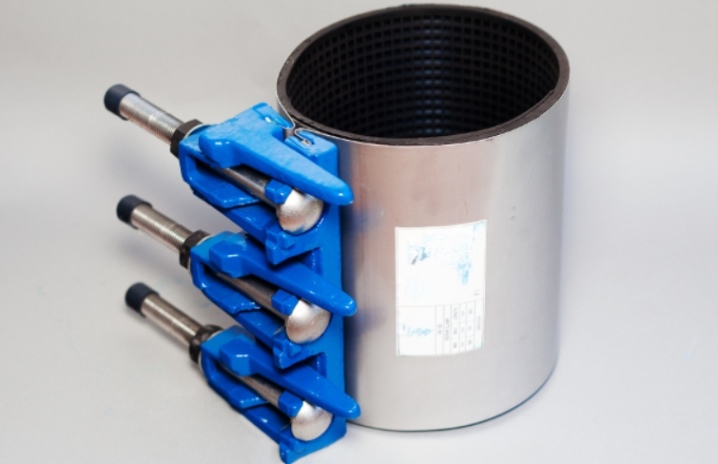
Species overview
Repair and connecting clamps are classified according to 2 characteristics: the material from which they are made and design features.
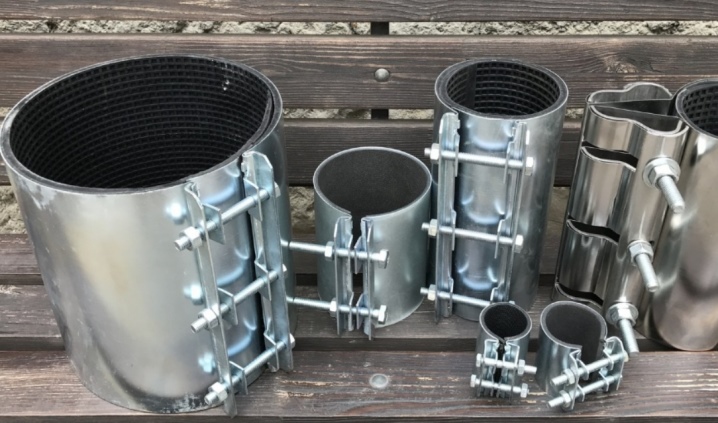
By design
Products can be single-sided, double-sided, multi-piece and fastening. The first look like a horseshoe. There is an active perforation on their top. They are intended for the repair of small pipes with a maximum diameter of 50 mm.

The design of double-sided clamps includes 2 similar half-rings, the connection of which is made using 2 screws. The dimensions of such products are selected in accordance with the dimensions of the pipes being repaired.
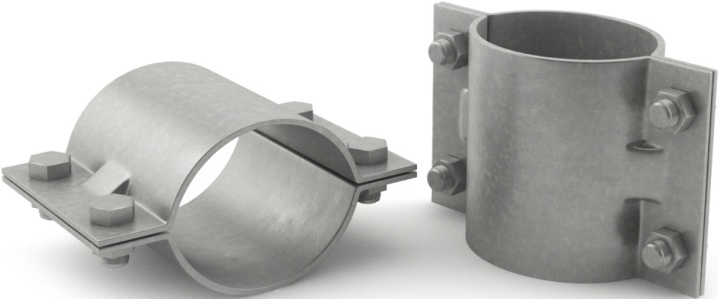
Multi-piece clamps include from 3 working segments. They are designed for the repair of large diameter pipelines. The clamp is often used to secure piping systems. It is mounted to the wall surface with a screw passed through the perforation at the bottom of the product.
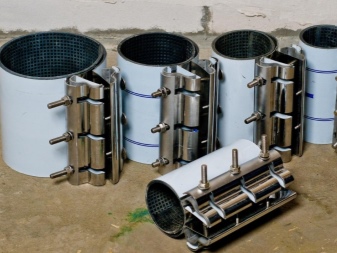
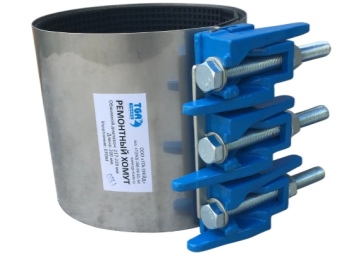
They also release clamps-crabs - semicircular products with 2 or more boltsdesigned for screed products on damaged areas of the pipeline. Parts with a cast iron lock are also on sale. Their locking part includes 2 halves, one of which has a groove, the other has a hole. They are fixed to the clamp band.
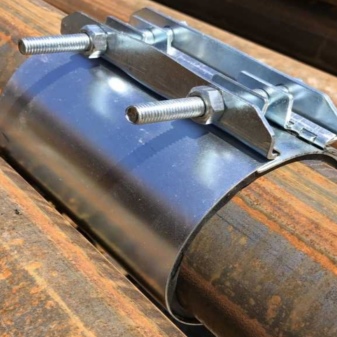
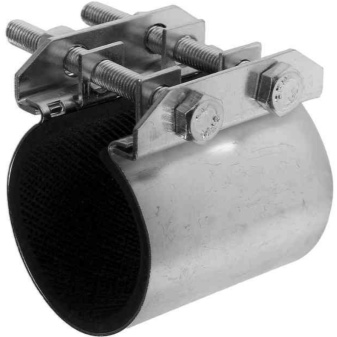
By material
In the manufacture of repair water clamps, various metals are used, less often plastic. Most metal products are made from steel. They differ:
- corrosion resistance;
- ease, thanks to which quick and uncomplicated installation is ensured;
- durability.
Steel clamps can be of any design.
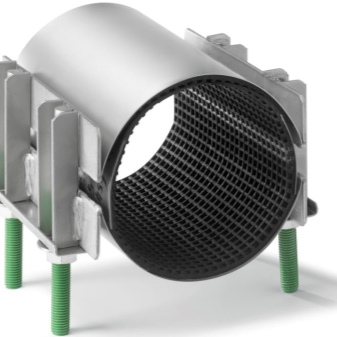
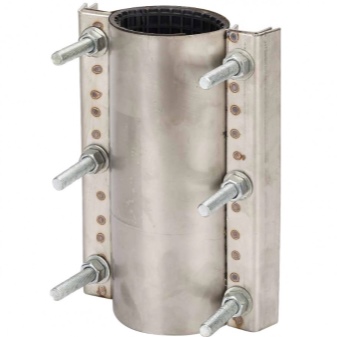
For the production of double-sided and multi-piece clamps, cast iron is used. Compared to steel products, cast iron is more durable and wear-resistant. However, they are more weighty and massive.
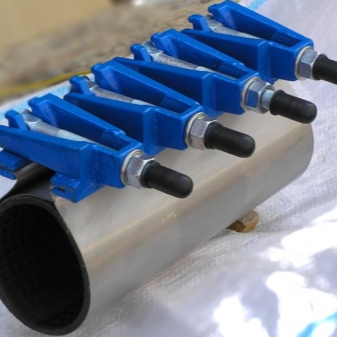
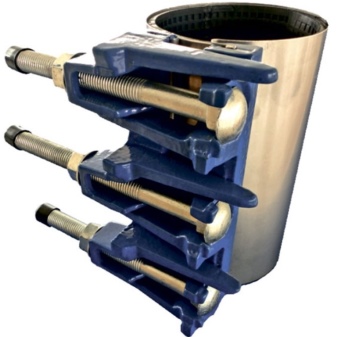
Clamps are also made of polymer plastic. Most often, these parts are used to fix the elements of moving pipelines. Such products are double or solid. The main advantage of plastic is its resistance to corrosion, however, the material breaks easily under various mechanical influences.
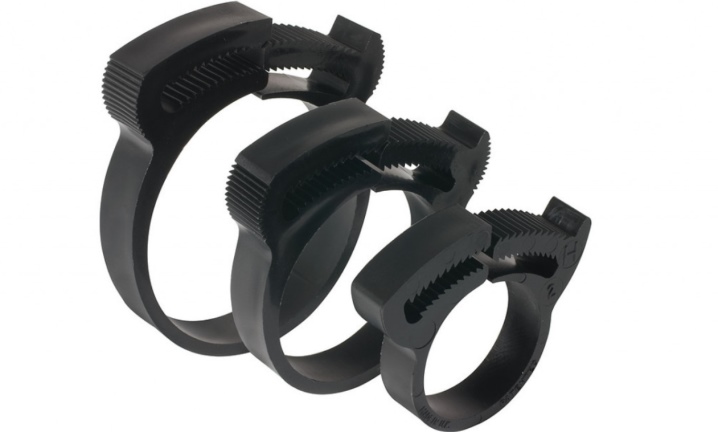
Specifications
In the manufacture of the bandage, galvanized or stainless steel with a thickness of 1 to 2 mm is used. Some manufacturers use 1.5 to 3 mm carbon steel. Steel products are stamped. In addition, cast iron can be used to make the bandage. Corrugated rubber acts as a seal. Fasteners are made of galvanized steel or alloy steel.
Description of technical characteristics of clamps with a rubber seal:
- the maximum allowable pressure is from 6 to 10 atm;
- working media - water, air and various inert gases;
- the maximum permissible temperature is +120 degrees;
- permissible operating temperature fluctuations - 20-60 degrees;
- the values of the minimum and maximum diameters are 1.5 cm to 1.2 m.
If properly secured, the clamp will last at least 5 years.
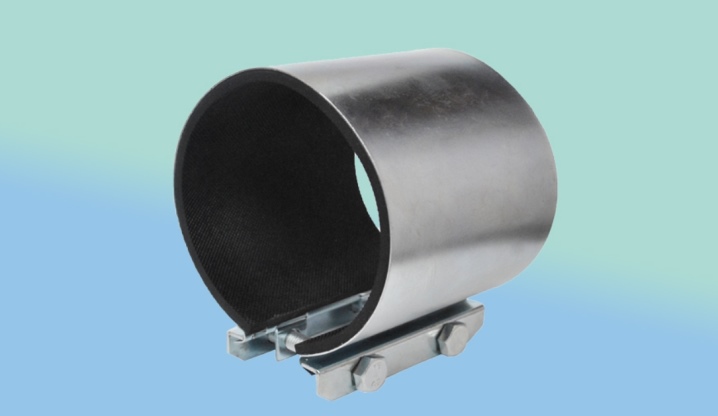
Dimensions (edit)
GOST 24137-80 is the main document regulating the manufacture and use of repair clamps. Such products are of standard sizes. They are selected taking into account the diameter of the pipeline. For repairing small pipes as small as 1/2 "it is recommended to use 2" one-sided clamps with rubber bands. - these are the most popular repair products. And also parts with a diameter of 65 (one-sided clamp), 100, 110, 150, 160 and 240 millimeters are common.
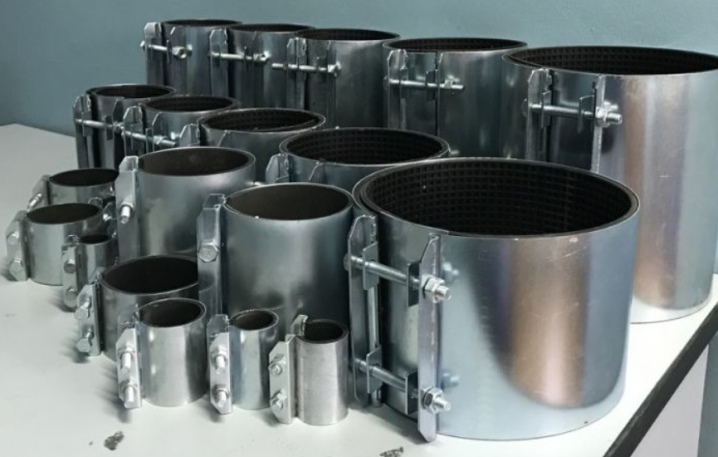
Operating conditions
Different clamp models have different characteristics. The operating conditions must meet all the parameters of these repair parts. Primary requirements:
- it is unacceptable to use clamps, the length of which is less than the diameter of the pipeline section being repaired;
- when sealing plastic pipes, it is recommended to give preference to connecting products that have a length of 1.5 times longer than the damaged area;
- if it is necessary to join 2 pipe segments, the distance between them should be approximately 10 mm.
Clamps can be used only in situations where the area of the damaged area is no more than 60% of the area of the repair and connecting clamp. Otherwise, it is advisable to use repair couplings.
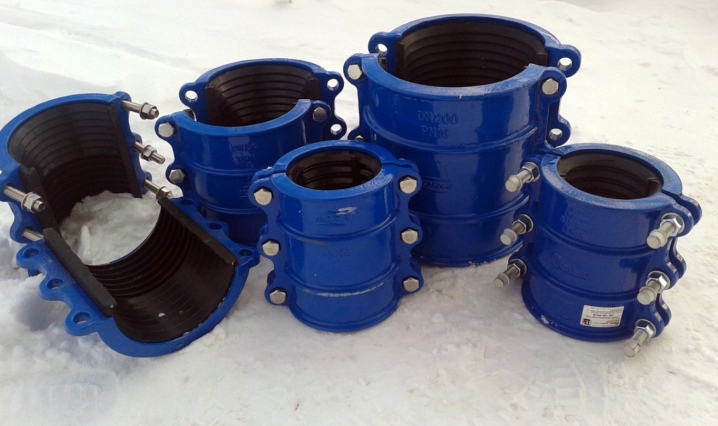
When installing the clamps, it is important to take into account the technical operating conditions of the piping system. For example, they cannot be used for sealing pipes with a pressure exceeding 10 atmospheres. In this case, the repair will be ineffective - the risks of repeated leaks will be too high.
In addition, it is worth considering the type of damage. To eliminate fistulas in water supply pipes, it is recommended to use clamps with an elastic seal. If you do not have the necessary tools at hand, it is best to use a product with a lock for secure fixation. If you plan to repair the pipeline with the maximum allowable pressure values, it is advisable to give preference to repair clamps, which are clamped using bolts and nuts.

Mounting
Installing a repair clamp on a problem section of the pipeline is a simple task that even an inexperienced craftsman can handle. The work must be carried out in a certain sequence.
- First of all, you need to clean the peeling rust next to the damaged pipeline. For these purposes, you can use a metal brush or sandpaper.
- The clamp fasteners need to be unscrewed, and then the ends should be spread to the optimal width - the part should easily fit on the pipe.
- When positioning the product, make sure that the rubber seal is over the damaged area and completely covers it. In the best case, the edge of the rubber seal should protrude 2-3 cm beyond the crack, fistula or other defect.
- The product is fastened by inserting the fasteners into the holes specially designated for this. Next, tighten the nuts until the damaged area is completely blocked. It is necessary to tighten the fasteners until the leaks are completely eliminated.
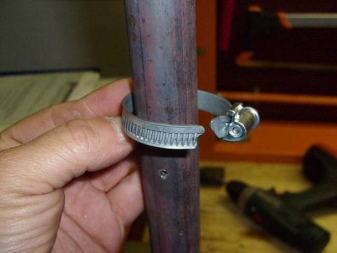
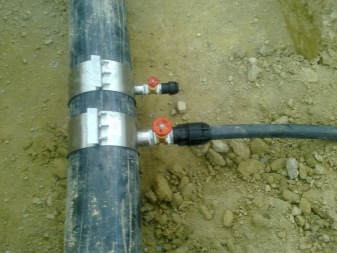
The quality of the repair performed will directly depend on the material of the clamp and the area of the cuff junction.
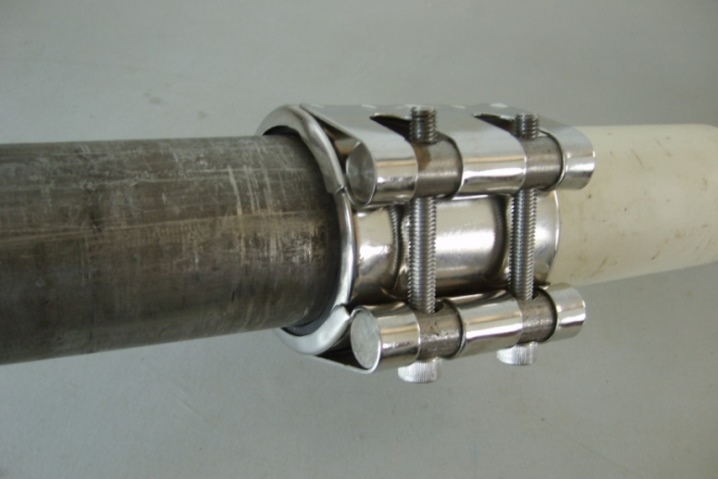
See below for more details.













The comment was sent successfully.